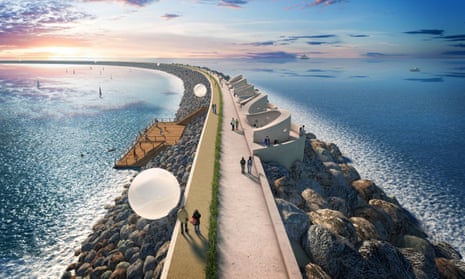Ministers have been urged to stop dithering and strike a subsidy deal for a pioneering tidal lagoon in Wales, after a government-commissioned report enthusiastically backed the technology as a reliable source of indigenous, affordable and clean energy.
Charles Hendry, a former energy minister, said his independent review of tidal power had concluded a small trial lagoon at Swansea Bay was a “no regrets option” that could open the way to at least five other full-scale projects around the UK.
The Labour MP for Newport West, Paul Flynn, called tidal power “Wales’s North Sea oil”, and Stephen Kinnock, Labour MP for Aberavon, said he was “absolutely delighted” at the green light given by the former energy minister.
The company Tidal Lagoon Power, which has proposed the project for Swansea, has already spent £35m on the south-west Wales lagoon. It said that if a subsidy deal could be agreed with the government construction could start next year and provide 2,000 jobs.
The company wants to build a U-shaped breakwater across the city’s bay and use the incoming and outgoing tides to turn a bank of 16 hydro turbines in the breakwater to generate enough electricity for 150,000 homes.
“I don’t think I have ever been to a community where people are so enthusiastic about a power station. They see this as the project that will bring about the city’s regeneration,” said Hendry.
While environmental organisations, engineering groups and several analysts welcomed the review verdict, some conservationists raised concern over the impact on birds and fish. There is also a campaign against a quarry in Cornwall that would provide the rock for the breakwater wall.
But Hendry said he believed tidal power’s opportunities outweighed the risk, and argued that the evidence was clear that the lagoons could be cost effective and affordable. “I would strongly caution against ruling out tidal lagoons because of the hopes of other cheaper alternatives being available in the future,” he said.
The subsidy for Swansea would cost households about 30p on their energy bills annually over the first 30 years, or “around the cost of a pint of milk”, he said. Five full-scale projects proposed by Tidal Lagoon Power, at Cardiff, Newport, Colwyn Bay in north Wales, the Cumbrian coast and Bridgwater Bay in Somerset, would add less than 50p over their first 60 years, the review concluded.
Hendry’s review was far more positive than many expected when it was commissioned by George Osborne, as chancellor, and Amber Rudd last February, as the government’s appetite for tidal power was seen to be cooling.
Labour echoed Hendry’s call for ministers to swiftly conclude negotiations with Tidal Lagoon Power on the guaranteed price of electricity from the Swansea project. “The government has repeatedly delayed this project, despite Labour backing it months ago. It’s time to stop dithering and get it built,” said the shadow energy secretary, Clive Lewis.
The price is expected to be similar to the £92.50 per megawatt hour agreed for power from the Hinkley C nuclear power station but over a far longer period than the 35-year nuclear deal with EDF. Hendry said he preferred a 60-year subsidy deal to the 90 years that has been floated, to minimise risks to the government.
John Feddersen, chief executive of analysts Aurora Energy Research, said: “As a trial to see if it works, yes I think Swansea is a sensible thing to do [on cost].” The group said that if 10 lagoons were built in the UK by 2030, these would provide 10% of electricity generation, cut carbon emissions by 36%, and add £8 to £9 to the average annual household energy bill.
The conservation group WWF-UK said tidal power had “considerable potential for generating clean electricity”, and Greenpeace hailed the Swansea project as “an opportunity to lead in generating clean power from Britain’s tides”.
Athanasios Angeloudis of the department of earth science and engineering at Imperial College London, said: “The UK is blessed with some of the largest tidal energy resources in the world and this outcome should be seen as a landmark step towards making the first significant contribution to the national electricity mix from this sustainable energy source.”
Mark Shorrock, Tidal Lagoon Power’s chief executive, said he looked forward to working with government officials to bring the industry to life. “Swansea bay tidal lagoon is a vision of how Great Britain can replace part of our ageing power station fleet with low cost, reliable power that also revitalises our industrial heartlands and coastal communities,” he added.
The Wales Wildlife Trusts and the RSPB said they were worried about potential local ecological impacts from the lagoons. But Hendry said after Swansea was operational in 2022, there should be a pause of up to two years before the five bigger lagoons were approved, and any environmental problems could be weighed up then.
The Policy Exchange thinktank and consumer group Citizens Advice raised concerns over tidal power’s cost. The business secretary, Greg Clark, said he welcomed the review into the “untried technology” and he would consider Hendry’s recommendations before responding.

Comments (…)
Sign in or create your Guardian account to join the discussion